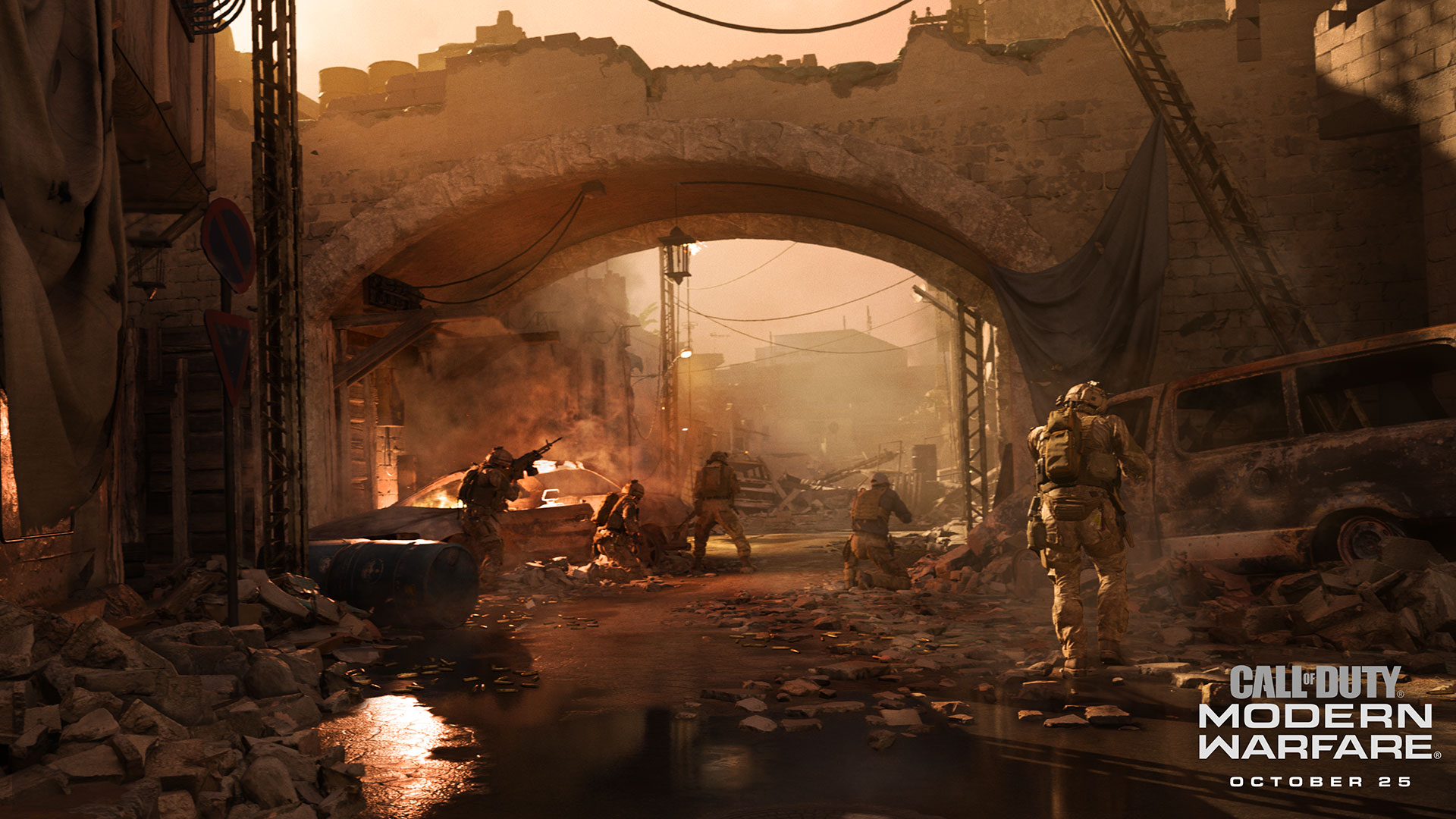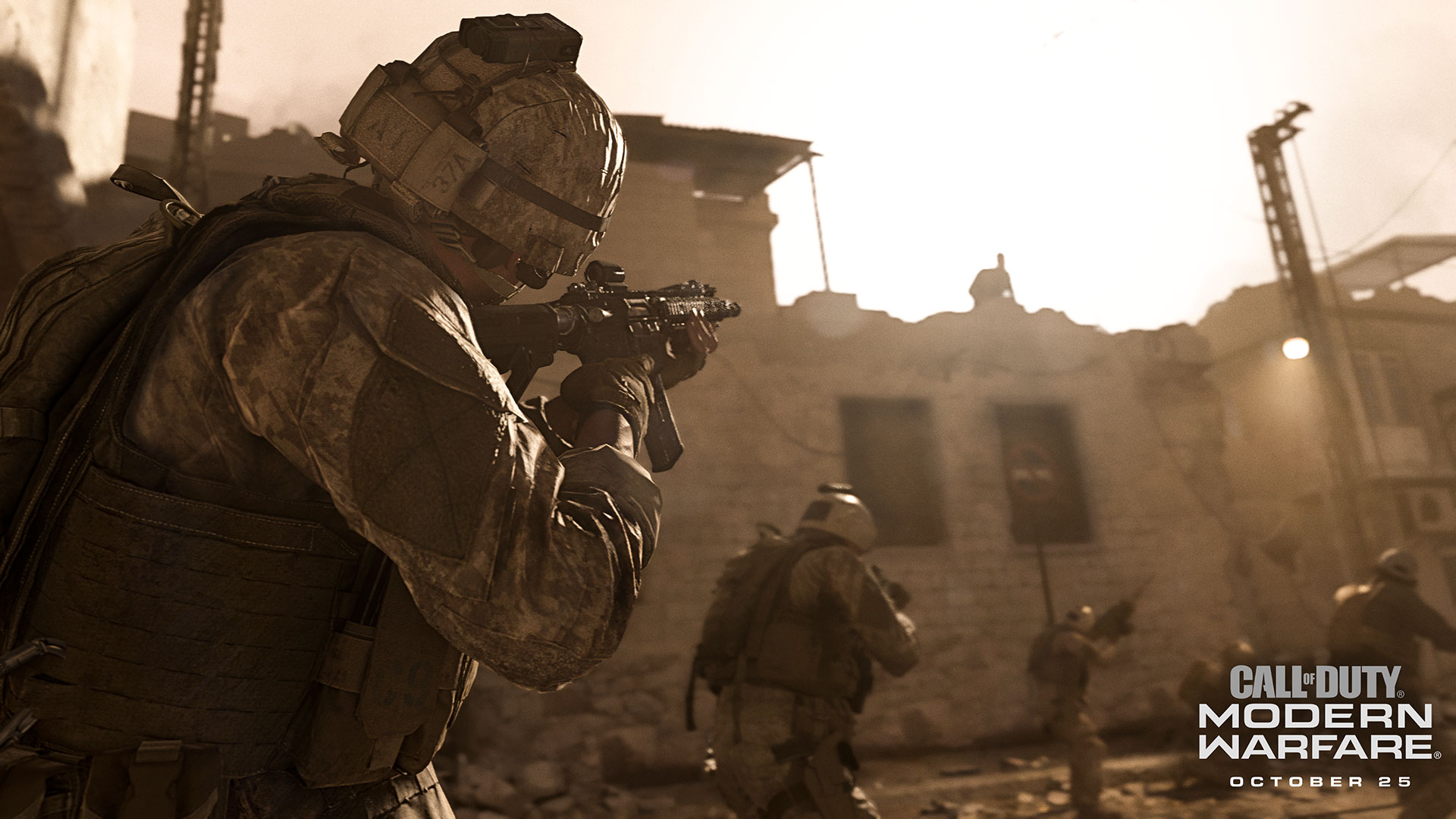At the start of Call of Duty: Modern Warfare’s development over two years ago, Joel Emslie was reminiscing:
“I’d seen Call of Duty®: Modern Warfare® Remastered and it had given me ‘all the feels’ again.” Despite the jump in visual fidelity of that title, Infinity Ward wanted the next Modern Warfare® to be different, with a much bigger jump in graphical quality. They loved Remastered, but the goal, from the inception of Modern Warfare, was “to make a visceral, real-looking game.” That prospect became a reality one day at Infinity Ward: “I was walking past an office, and someone was screwing around with photogrammetry.”
Photogrammetry: Bad-Ass Looking Garbage on the 118
What is photogrammetry? Dating back to the middle of the 19th century (in its simplest form), this technique uses photographs to make comparative and accurate measurements, usually in order to precisely show a location, scene, or object. Today, this results in the ability to construct highly-detailed 3D models. Or as Joel describes it; “take a thousand different photos of a particular room from different angles, feed it into a magic computer, and it’ll spit out a mesh [that looks real]. Like a 3D version of a room, exact to the micron.” Initial photogrammetry results using the new game engine behind Modern Warfare were so impressive, that the studio began to galvanize into art teams with one overriding goal in mind. Joel explains: “During the past two years, the trick was to apply photogrammetry into the [Modern Warfare] environments without messing up all the game design.”
Teams began to fan out to find examples of a wide variety of objects they could photograph: “We started going out and collecting data, around the [neighborhoods near the Infinity Ward] office at first.” Joel was particularly keen on detritus, rubble, and other scenery he knew would be needed for the game. In particular, he remembers taking “images of some bad-ass looking garbage on [State Route] 118.” During this formative period, Infinity Ward “created a team of people that educated [themselves], and learned, and understood photogrammetry techniques to try and push the effort. We even tried designing our own devices, like poles, to take shots from all kinds of different angles. We got really good at it.”
Integration: Close-up Details, Corpse Creation, and More
With all of this visual data, the art teams began to construct environments using the new game engine, which was already well into production, before upping the quality of the graphics considerably using a tiling technique, adding additional detail for times when you’re close to an object (like a rotting red leather sofa, a crumbling wall, or the brick work of a London townhouse). “You get really close to walls, and when you see things up close, [you’re seeing] this detailed tiling technique where you can really notice the detail. You’re probably familiar with 16 or 32 pixels per inch; this will be 64 pixels per inch; almost as real as it gets.”
Crumpled corpses are another way to increase the seamless believability of the environments. Joel tells us; “I like to get a bit experimental.” So they started to drop in “meat bags.” These bodies were “actually one of our in-house devs: There was a casting call one day, [asking] ‘who wants to get dressed up as a dead corpse and lay in the scanner’? It actually doesn’t take a long time to scan, it’s just a camera snap, and 160-200 cameras go off at once. It takes one shot, which then takes six hours to process.” Again, the results continued to impress:
“When you pose a character, you don’t fully get the nuance of the skin, or gravity, essentially the realistic effects of gravity and physics at work.” It seemed that scanning developer-shaped meat bags allowed the team to drape and position expired remains with a new level of believability.
The same was true with masonry and structures. Legacy techniques were mothballed, while the team took advantage of the abilities of that the new game tech allowed. Joel again: “We’d done this for years; environment artists [would] sometimes end up hand-placing every single brick [at a location]. It looks good, but it doesn’t look as real. Not like this.” Instead, when twisted metal rebars, rusted piping, or other scenic necessities were needed, a quick field-trip was organized: “We went out to a quarry, stacked bricks, or went out to dilapidated wrecks and ruins, and we captured all this data, brought it in, and integrated it into our [in-game] environments.”
Environmental Advancements: Sprawling and Intimate Settings
Now the team goes anywhere, and scans anything they need. One example is an entire Russian tank. “This is… fully scanned, we got underneath it, I’ve no idea how. I guess they lifted it up and scanned it. But it makes for a smoking hot prop. When you see these things rolling around, it’s just completely convincing.”
As the scope of the possible ways to use photogrammetry grew, Joel tells us the team “started getting super-creative, and we heard about people using drones to scan [environment]. We’d go out to an area to get a good example of an expanded environment, and we’d pop a drone up, and we would sweep coastlines, we would sweep deserts, mountains, and forests, and we would bring all this data back.” That data would prove to be extremely important, as the size of the levels (or as Joel describes, the ‘sets’) of the game also grew: “We started to make this super-convincing far, mid, and close periphery areas to expand the ‘set’. It’s a big game. You can reach out with a 12x and snipe in on this stuff and glass it [from extreme range], as well as getting real close to it. You need to have all that detail; you have to see details on cement [scenery for example]. We have some sets that just go on and on and on…”
Even the most convincing townhouse, rebel stronghold, or mountain hideaway wouldn’t be worth painstakingly crafting together if the AI inhabitants weren’t rendered to the same quality. Joel and the art teams worked tirelessly to ensure believability across the board.
“Putting it all together, and seeing our characters in the environment, we did a massive amount of [work] on our shaders and on our materials to make sure that… this was a challenge. If we have an environment that’s as real [as a photograph], everything else has to be photographically real too. If you put in a made-up character in a realistic environment, they look completely inappropriate; it looks awful. We really had to work hard on that.” How hard?
“We turned ourselves into a traditional Hollywood model shop.”
More on that later.
Operator Overviews: Dressed for Success
This standard, naturally, extends to the outfits and garb each entity in the game wears or carries on their person. Even the screen where you choose an Operator to play as in Multiplayer was painstakingly realized. “The [operators] and characters you work with are all standing in a photographic real environment. If you zoom in and zoom out you can see the environment parallax, it’s dimensional; it’s a photographic projection technique. This is a real space that we went to – a prop house – we got everybody out of the studio that day, and we got props, and we set-dressed, and we shot all of this, creating a realistic environment, but our goal is that every time we show you something, it needs to feel real. It can’t be just a character spinning in a black space, or some kind of low-res, crappy environment.”
Breaking out real-life props and making photo-realistic in-game versions of them, leads to some truly impressive results. Take Operator Grinch, who wears the ghillie suit, for example:
“I’ve been chasing after stuff like this for years.” Joel tells us, with a laugh: “I did the original ghillie suit,. I don’t get to [design] this, a character artist that I work with now totally kicked my ass, so they get to do it, and I get to kind of admire how badass that is.” It’s not only impressive to look at, but like the atmospheric environments, it’s also designed to aid gameplay. “What’s cool about this is; it’s concealment. You can crawl round, smith your gun a certain way, put some ghillie on it, and crawl around and use it properly.”
As we watched another playable Operative (“Zane”) on-screen, we marveled at the utterly believable torso-length cape flapping and draping over the character’s body armor. Joel was quick to correct us:
“That is not a cape, it’s a tactical poncho.”
“I saw this thing a few years back and thought it was awesome, so we went after it, and found the right character for it. This is stuff I’ve been wanting to do for years that we couldn’t. At one point I was told I couldn’t do high collars or low jackets on characters, and now we can do a full poncho. This dude’s badass!”
Joel brings up another character; an operative named Kreuger, wearing a helmet with camouflage “frogman” netting shrouding the entire face and shoulders. “We’ve been chasing this type of character design for I don’t know how long. I’ve tried, and failed miserably until now, when we’ve got it right. There’s so much happening to make this look right. The cloth and the netting on his hat have to look a certain way, to render a certain way, and you have to see through it.”
Prop Hunt: Authentic Equipment and Weaponry
Looking at the spots of mud, creases and divots in the leather, and stains on the material of individual items adorning each operative, it became clear that authenticity was paramount in adorning each character. Joel agrees: “With our character department, we turned ourselves into a prop house. We’ll actually take the shoes, go hiking in them, throw them in a pool, leave them there for a week, pull them out, distress everything. We’re down there with dremel tools, scraping things and making things look worn.” The physics engine also ensures hanging cloth sways in just the right manner, too.
Finally, we took a look at the player’s gun bench, where loadouts are chosen, and weapons are augmented. “This is where you disassemble and arrange your stuff, where you trick out your weapons and do all the cool things that go along with that.” The bench, the scattered shells and bullets, and the weaponry on show… it all looks real. The challenge I had when we started this? Give me a still [screenshot] of this and let me build something that looks like a [gun enthusiastic] magazine cover to see if we could fool people. I think we’re getting there. This is still pre-alpha.”
“By the way, this is all on the PlayStation® 4.”
Additional Intel: Don’t Be Kept in the Dark
How does Infinity Ward obtain such impressive visuals no matter what hardware is utilized? That’s down to the new game engine, overseen by Principal Rendering Engineer Michal Drobot. Join us soon for an in-depth overview of the tech present in Call of Duty: Modern Warfare.
Pre-orders at participating retailers are available now, or at CallofDuty.com.
For more information and the latest intel on Call of Duty®: Modern Warfare®, check out: www.callofduty.com, www.youtube.com/callofduty and follow @InfinityWard and @CallofDuty on Twitter and Instagram and Facebook.
For more information on Activision games, follow @Activision on Twitter, Facebook, and Instagram.




